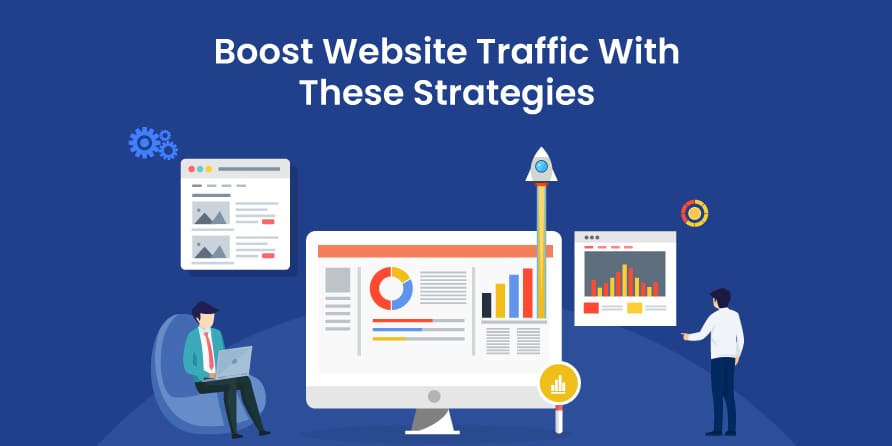

In the evolving e-commerce environment, blogs can undoubtedly be an impactful tool to boost your website’s traffic and engage with your audience. It serves as a gateway to engage with your audience, increase traffic visits to your website, and ultimately boost sales. However, achieving success with an e-commerce blog is not merely churning out content; it requires a strategic approach.
HubSpot, a leading inbound marketing and sales platform, offers a versatile toolkit with features designed to elevate your e-commerce blog to new heights.
BOOST WEBSITE TRAFFIC WITH THESE STRATEGIES

1. Content is King: Create High-Quality Content:
The foundation of any successful blog is high-quality content. HubSpot’s content management system (CMS) allows you to create and manage blog posts easily. When crafting your content, ensure it is informative but also engaging and well-researched. Think about what topics your audience is interested in and what problems they need to solve.
One way to generate content ideas is using HubSpot’s keyword research tools. Then identify relevant keywords and phrases your potential customers are searching for and incorporate them into your blog posts. It will enhance your search engine ranking and attract organic traffic to your blog.
2. Leverage HubSpot’s SEO Tools
HubSpot provides robust SEO tools to help optimize your blog content. Utilize these tools to improve your blog’s visibility in search engines. Most importantly, optimize your blog post titles, meta descriptions, and headers with relevant keywords. HubSpot’s SEO recommendations will guide you in optimizing your content effectively.
Additionally, HubSpot offers a content strategy tool that helps you plan your blog content for optimal SEO performance. By analyzing your target keywords, competition, and performance, you can refine your content strategy to drive more organic traffic to your e-commerce site.
3. Utilize Email Marketing
One of the most effective ways to promote your blogs and drive traffic to your e-commerce site is through email marketing. HubSpot’s email marketing tools make it easy to create and send customized emails to subscribers you have. Now, every time you publish a blog, send out a newsletter or notification to your subscribers, enticing them to visit your blog.
Segregate your email list to ensure that all your subscribers receive content relevant to their interests and needs. This personalized approach increases engagement and encourages more clicks to your blog. HubSpot’s email analytics will help you track the success of your email campaigns and will aid – in refine your marketing strategy for maximum impact.
4. Engage with Social Media
Social media is a powerful space to promote blog content and drive traffic to your e-commerce site. HubSpot’s social media management tools enable you to schedule and publish posts across various social networks. Share the blog posts on platforms like Facebook, Twitter, Instagram, and LinkedIn to reach a broader audience.
To boost engagement, use eye-catching visuals, compelling headlines, and hashtags related to your blog content. Encourage your followers to share your posts, amplifying your reach and driving traffic back to your blog.
5. Landing Pages and Call-to-Actions (CTAs)
HubSpot provides tools for creating landing pages and CTAs that can help convert blog visitors into customers. When writing blog posts, include CTAs encouraging your readers to take specific actions, such as subscribing to your newsletter, downloading a case study or e-book, or purchasing.
You can also create dedicated landing pages for specific blog posts, offering additional information or resources related to the blog topic. These landing pages can capture leads and guide them toward the desired conversion, whether signing up for your e-commerce site or making a purchase.
6. Lead Nurturing
E-commerce businesses can benefit from lead nurturing workflows provided by HubSpot. When a visitor subscribes to your blog, they become a lead. You can create automated workflows that send personalized content and offers, gradually guiding them through the buyer’s journey. As they become more engaged with your content, the chances of conversion increase.
Segregate your leads based on their interests and behavior, tailoring your email campaigns and content recommendations accordingly. HubSpot’s lead nurturing tools make it easier to build relationships with leads and to convert them into paying customers.
7. Monitor and Analyze Your Blog’s Performance
To fine-tune your e-commerce blog strategy, you must continuously monitor and analyze your blog’s performance. HubSpot’s reporting and analytics tools provide valuable insights into the effectiveness of your content and marketing efforts.
Keep an eye on key metrics like traffic, conversion rates, bounce rates, and engagement. Use these insights to identify what’s working and what needs improvement. HubSpot’s reporting dashboard lets you to track your blog’s growth over time, ensuring that your strategies are delivering the desired results.
8. User-Friendly Design and Mobile Optimization
In the e-commerce world, the user experience is crucial. HubSpot’s website design and optimization tools enable you to create a user-friendly blog layout that enhances navigation and readability. Ensure that your blog is mobile-responsive, as many users access content on smartphones and tablets.
A mobile-optimized blog provides a seamless experience for visitors, increasing the likelihood of them exploring your e-commerce site further and making a purchase. HubSpot’s templates and design tools make optimization easy to create a blog that looks great on all devices.
9. Patience is Key
Building a successful e-commerce blog with HubSpot takes time and consistency. Don’t expect overnight results. Keep publishing high-quality content, engaging with your audience on social media, and refining your strategies based on analytics.
Consistency is the key to building a loyal readership and increasing your blog’s traffic. Over time, as your content gains authority and your audience grow, you’ll see a significant boost in your e-commerce site’s traffic and conversion rates.
Conclusion
HubSpot offers a comprehensive set of tools and features that can significantly enhance your e-commerce blog’s performance. By creating high-quality content, utilizing SEO tools, engaging in email marketing and social media, and optimizing user experience, you can increase your blog’s traffic and boost your e-commerce sales. With patience and a well-executed strategy, you can leverage HubSpot to achieve remarkable results for your online store.
At The Higher Pitch, we excel in driving website traffic through effective content strategies and practices. We combine imagination and technology to make brands unique, and our tailored HubSpot services and expert advice are geared towards helping your team maximize the power of HubSpot to boost website traffic.
Elevate your business with HubSpot’s Inbound Marketing and Sales Automation.
Related blogs

Let’s start a brand-new story!



